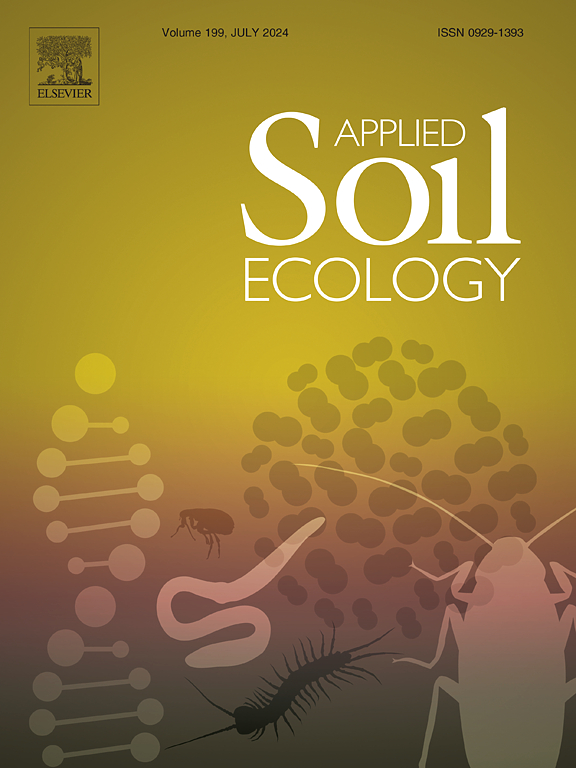Nematode communities respond more to N enrichment than to plant community changes over decades in tallgrass prairie
IF 4.8
2区 农林科学
Q1 SOIL SCIENCE
引用次数: 0
Abstract
Temperate grasslands such as the North American tallgrass prairie are among the most endangered terrestrial ecosystems due to changes in climate and land-use practices. While belowground responses of terrestrial ecosystems to perturbations have received greater attention in recent years, there is a dearth of long-term studies documenting changes over decadal scales. The current study addresses the long-term effects of fire (annual burning or fire exclusion), mowing, and nitrogen (N) and phosphorus (P) fertilization on the structure and composition of a tallgrass prairie nematode community after 32 years of experimental treatments. Fire exclusion resulted in conversion of grassland to woodland, and a general decrease in nematode population densities, while annual prescribed fire maintained a grassland state. Although the change in vegetative state affected overall nematode abundance, vegetative structure was not the major driver of nematode community composition. Rather, changes in nitrogen availability appeared to be the dominant driver of nematode community dynamics. Responses of herbivorous taxa were dominated by interactions among burning, mowing, and N fertilization treatments and varied across taxonomic groups, but a general pattern of increasing relative abundances with N fertilization was observed, particularly in the presence of annual burning or mowing. In contrast, the relative abundance of the fungivorous Tylenchidae, the dominant nematode family in terms of abundance, declined from 44 % to 26 % after 32 years of N enrichment, while fire exclusion favored the opportunistic bacterivorous Rhabditidae. Although higher trophic level responses were generally uninformative, our results confirmed the value of nematode community analysis in soil food web diagnostics, with fungivore to bacterivore ratios and the maturity index (MI) identified as useful community indices.
高草草原线虫群落对N富集的响应大于对植物群落变化的响应
由于气候和土地利用方式的变化,北美高草草原等温带草原是最濒危的陆地生态系统之一。虽然近年来陆地生态系统对扰动的地下响应受到了更多的关注,但缺乏记录十年尺度变化的长期研究。本研究通过32年的试验处理,探讨了火(每年燃烧或禁火)、割草和氮磷施肥对高草草原线虫群落结构和组成的长期影响。禁火导致草地向林地转化,线虫种群密度普遍下降,而年度规定火维持草原状态。虽然营养状态的变化影响线虫的总体丰度,但营养结构不是线虫群落组成的主要驱动因素。相反,氮有效性的变化似乎是线虫群落动态的主要驱动因素。草食性类群的响应主要由焚烧、刈割和氮肥处理之间的相互作用所主导,并且在不同分类类群之间存在差异,但总体上观察到氮肥处理的相对丰度增加,特别是在每年焚烧或刈割的情况下。相比之下,富氮32年后,以真菌为主的线状线虫科(Tylenchidae)的相对丰度从44%下降到26%,而不加火则有利于机会性细菌线状线虫科(Rhabditidae)。虽然更高营养水平的响应通常不具有信息性,但我们的研究结果证实了线虫群落分析在土壤食物网诊断中的价值,其中真菌与细菌的比值和成熟度指数(MI)被确定为有用的群落指标。
本文章由计算机程序翻译,如有差异,请以英文原文为准。
求助全文
约1分钟内获得全文
求助全文
来源期刊

Applied Soil Ecology
农林科学-土壤科学
CiteScore
9.70
自引率
4.20%
发文量
363
审稿时长
5.3 months
期刊介绍:
Applied Soil Ecology addresses the role of soil organisms and their interactions in relation to: sustainability and productivity, nutrient cycling and other soil processes, the maintenance of soil functions, the impact of human activities on soil ecosystems and bio(techno)logical control of soil-inhabiting pests, diseases and weeds.
 求助内容:
求助内容: 应助结果提醒方式:
应助结果提醒方式:


